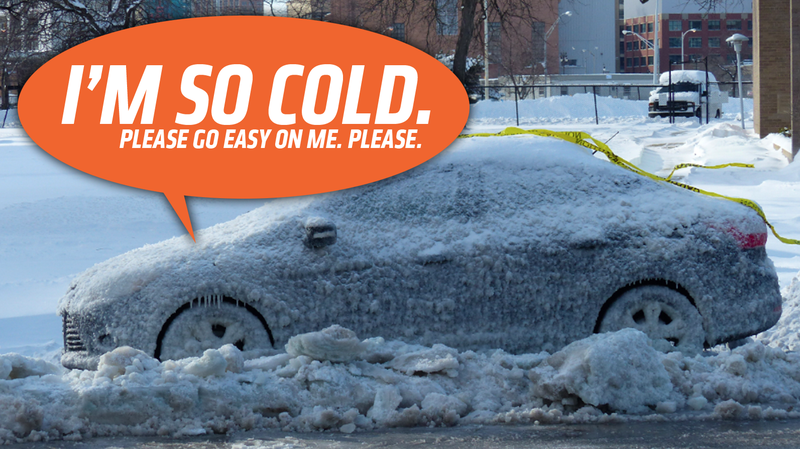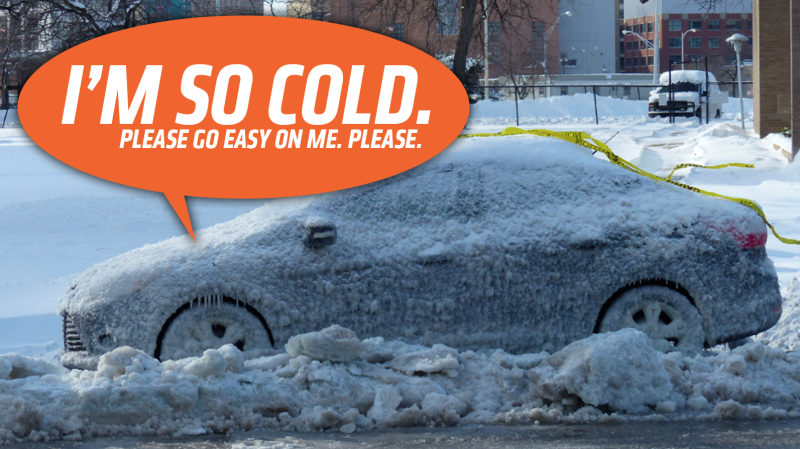
Recently, a reader criticized a comment I wrote a while ago in which I claimed that it harms your engine if you hoon it while cold. While I stand by the comment, I’ll admit that it was unsatisfying and devoid of detail. So I reached out to a powertrain engineer to help me fill it in a bit.
This again. Yes, I’m breaching the controversial winter weather topic “Should I warm up my car before driving it?” Why? Because just look at how upset reader “Left Lane is for Passing” is about this comment I made in my pre-Jalopnik days:
And this person (who, it’s worth mentioning, has a flawed concept of oil temp vs viscosity relationships) wasn’t the only one who expressed concerns with my comment. To address these debates as best I could, I reached out to Dr. Andy Randolph, technical director at ECR Engines—a NASCAR engine developer based out of Welcome, North Carolina—and a man with a Ph.D in chemical engineering and decades of experience working on powertrains, including at General Motors.
The Automotive Aftermarket Products Expo, for whom he was a guest speaker last year, calls Dr. Randolph a “strong advocate of applying scientific principles to engine development” and says he’s “widely regarded internationally as one of the foremost applied combustion experts in the world.” You can read more of his bio here, but suffice it to say: He’s an engine nerd.
Advertisement
After I asked for his expertise on the wear benefits of letting a cold motor idle and warm up prior to driving, Dr. Randolph broke the situation down into two factors: the sensitivity of oil viscosity with respect to temperature, and engine metals’ thermal expansion or contraction with respect to temperature, saying:
Cold engines suffer from two problems. The first is that the oil is cold causing it to have a much higher viscosity. Multi-vis[cosity] oils attempt to address this issue by mixing low-viscosity constituents with high viscosity constituents to create an oil that works at both cold and hot extremes, but nevertheless viscosity still increases rapidly as temperature drops.
When below freezing the oil can become too viscous to flow through some of the smaller lubricating passages in the engine, thereby starving some rotating and reciprocating components of oil until the metal and fluid temperatures increase. Additionally, the oil pump can cavitate on the inlet side, rendering it unable to generate pressure on the outlet side.
Advertisement
Then he talked about bearing clearances affected by thermal contraction of disparate metals found in some engines:
The second problem is that most engines are constructed of aluminum these days which has a much higher coefficient of thermal expansion than the old cast iron structures. Thus, under extremely cold conditions the clearance between some of the key mating parts gets very small.
Of particular concern is main bearing clearance where the main bearing housing (the engine block) is constructed of aluminum and the crankshaft is constructed of steel. Thus, the aluminum housing contracts much more than the shaft and the bearings get extremely tight. The combination of reduced bearing clearance and lack of oil flow is a recipe for metal-to-metal contact and rapidly increased wear.
Advertisement
His conclusion:
So on these cold winter mornings it is definitely best to let the engine run for a couple of minutes before putting it under load.
But of course, I had to ask how theoretical all of this was this was; would these affects be significant to an average customer—say, John Smith from Detroit, for example—who starts his engine and immediately drives to work (accelerating at fairly reasonable rates) every day for 15 winters in a row. Could his engine longevity be measurably reduced? I asked.
Advertisement
Dr. Randolph’s response:
Yes, certainly. It is really only a problem when John Smith does this under conditions like what is up north right now (sub-zero temperatures). John Smith should invest in a garage if he wants his vehicle to endure!
But wait. What’s with that “Stop hurting your engine by idling the car when it’s cold out” Business Insider story everyone’s been sharing—the one in which a mechanical engineering Ph.D. says warming your car up can actually cause harm because a prolonged cold idle during which the engine has to run rich can affecting lubrication effectiveness, possibly yielding premature cylinder and piston ring wear? Dr. Randolph admits there’s some truth to the notion, saying:
There is some truth to that in extreme situations, for instance people who let their engine idle for 15 minutes or more before beginning their daily commute. Only a couple of minutes are necessary to get the fluids flowing and temperatures increases to avoid premature wear. Extended time at idle eventually becomes too much of a good thing!
Advertisement
What about the “get the car to normal operating temperature” idea? Well, Randolph doesn’t think it’s necessary, saying:
[It’s] not required to get to full operating temperature! The metal temperatures ramp up much faster than the fluid temperatures and you only need to get the oil warm enough for it to flow (will be fine by 20C).
But what if it’s super cold outside, and oil won’t get up to 20C in just the “couple of minutes” of idle time Dr. Randolph prescribes? His answer:
Starting at -20C is approaching worse-case for being able to start (fuel won’t vaporize) and would definitely extend the times slightly. However, regardless of the ambient temperature, metal temperatures of rotating and reciprocating components heat up fairly quickly. Getting fluids to 20C would take more than two minutes when starting from -20 though, probably four to five minutes.
Temperatures that low are bad news for cars, period! Places that see those cold of temperatures frequently have engine block heaters on the cars and infrastructure to plug the cars in when parked outdoors.
Advertisement
It’s worth mentioning that Business Insider’s source recommends driving the car within 30 seconds to a minute of starting it, and driving it lightly thereafter. From that story:
“You will get the oil warmer faster, so that it’s flowing exactly the way it’s intended, if you drive the car lightly reasonably quickly [after turning it on], within say 30 seconds to a minute,” Ciatti said.
Despite this advice to go ahead and drive the cold car, the Business Inside article does advise against mashing the throttle as a way to avoid unnecessary wear. This aligns with Dr. Randolph’s first point.
Advertisement
But what about the key question: Should you idle the car for a few minutes to let the oils get up to temp, or should you just drive it lightly pretty much as soon as you get in, as is suggested in the Business Insider story? Well, the answer is “either” according to Randolph, who told me:
Idling for two minutes like I suggested versus idling for 30 seconds to one minute and then driving lightly initially are essentially the same. Either is fine.
But let’s be honest—most of this doesn’t matter to your average person, because your average person is going to warm his or her car up anyway. Nobody wants to be in a cold car, so why not tap that remote start button twice, and only have to endure cold for the five seconds it takes to get from your front door to your vehicle?
Advertisement
Is it that bad if we do this, though? Dr. Randolph doesn’t think so:
Most remote starts these days shut down the car after five minutes so multiple remote starts would be required to reach the ten minute mark. In my opinion the cylinder wall lubrication issue is minor and repeated remote starts will not cause a problem. Modern cylinder finishes and piston ring profiles are meant to withstand that environment. Too much idle time in cold weather is much better than too little!
So there. We’ve got Dr. Andy Randolph’s take on all of this: Idling to warm up your car isn’t a bad thing if it’s short, and if it’s longer than just a couple of minutes, that’s also not too bad, either. The key is, he says, to avoid hammering on your vehicle when your engine and engine oil are cold, as doing that could cause accelerated wear.
Advertisement
If you want to baby your vehicle while the engine warms up, you can totally do that instead of letting your car idle for a few more minutes, but as my coworker Jason pointed out in his article which also describes other non-wear-related reasons why you should warm you engine, that’s not all that practical:
Look, if you know you can drive it gently while the engine gets up to temperature, fine, have at it: but for most people, we don’t really know.
Will you need to accelerate suddenly to avoid danger? Who knows? It could happen. Will you have to detour and end up going up a steeper hill that requires more power? It can happen. And, remember, any hill will put your engine under load.
Ultimately, what’s the point of risking it? Why put yourself in a position where you could be needlessly causing engine damage?
Advertisement
Obviously, before I can say this issue been “put to bed,” I’d need to see some data of engine wear versus different warmup strategies (idling for a short while versus idling for a long while versus gently driving away while cold). Plus, there’s another factor in this “should I idle my engine to warm it up” besides just engine wear, and that’s fuel economy and emissions. I didn’t ask Dr. Randolph about this, and again, we’d need to see test data to prove that one strategy is significantly more efficient, but I think it’s safe to say that most people don’t care at all about fuel economy during an engine warmup—they just want some level of feeling in their butt cheeks.
So if it’s cold, take it from a powertrain expert: You should probably just let your car idle for a bit if you want to keep your buns warm and your motor happy.













